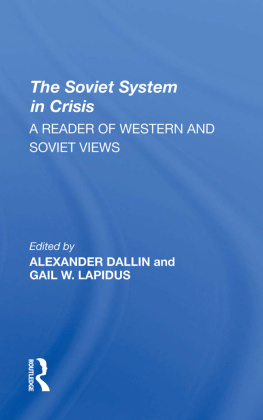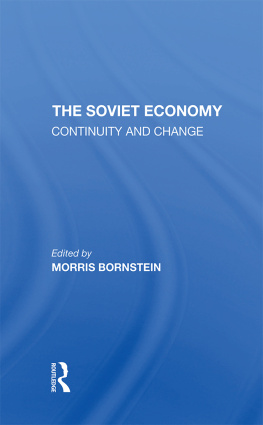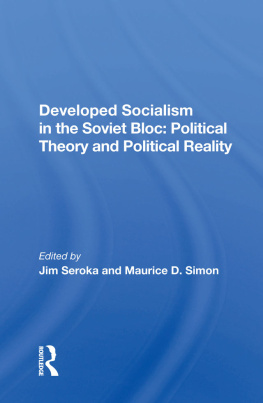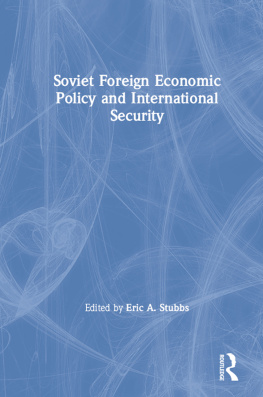First published 1991 by Westview Press
Published 2019 by Routledge
52 Vanderbilt Avenue, New York, NY 10017
2 Park Square, Milton Park, Abingdon, Oxon OX14 4RN
Routledge is an imprint of the Taylor & Francis Group, an informa business
Copyright 1991 by Taylor & Francis
All rights reserved. No part of this book may be reprinted or reproduced or utilised in any form or by any electronic, mechanical, or other means, now known or hereafter invented, including photocopying and recording, or in any information storage or retrieval system, without permission in writing from the publishers.
Notice:
Product or corporate names may be trademarks or registered trademarks, and are used only for identification and explanation without intent to infringe.
Library of Congress ISSN: 1057-1531
ISBN 13: 978-0-367-28842-6 (hbk)
1
Introduction: The Years in Review
Anthony Jones
At the beginning of 1989, in spite of the fact that social and economic problems were a cause for concern, the general mood was quite positive regarding the course of perestroika. At the close of 1990, however, the prevailing sentiments were those of pessimism and despair; the economy was in deep trouble, daily life was very difficult for most people, and there was genuine concern that the greater openness introduced by glasnost was coming to an end.
What, then, was the course of events that brought about this dramatic change of fortune? It is the purpose of this volume to provide a brief survey of the events of these two years, and to help readers to understand their significance in both the current period of transition and the longer-term development of Russia and the Soviet Union. Given the enormity of the changes that have occurred, it would be impossible for any book to be definitive in its coverage. Instead, the contributors were asked to write an account of the period 1989-1990, providing their own evaluations of what the most significant phenomena were. Of necessity, therefore, the chapters that follow reflect the choices made by the authors, as well as their own understanding of the meaning of the events of these two years.
Because in real life developments and events have an effect on many parts of the society at once, it is not possible to deal with, say, political and economic events in isolation from one another. The reader will therefore find a degree of overlap between the chapters, an overlap that we have resisted the urge to remove on the ground that it serves to help rather than to hinder the reader's understanding. We believe that it is an awareness of the interconnections that make the current changes understandable, and the chapters that follow provide considerable guidance on the complexity of the connections.
At the same time, it is as important to know the chronology of events, since this brings into focus the actions and reactions that are the stuff of history. While each chapter sets out the chronology of events in a particular sphere, such as the economy or ethnic politics, the reader also needs some guidance as to the sequence of events in general, to the "shape" of the two years covered in this book. What follows, then, is a highly selective survey of some of the events of 1989-1990, not so much a listing of everything that happened, but rather a coverage of enough of the highlights to indicate the directions in which society was moving, the forces that were emerging and competing for power, and the changes in direction that were becoming increasingly obvious as 1990 drew to a close.
1989: Revolution Abroad, Reform at Home
Winter : January 1989 saw the first maneuverings in the CPSU in preparation for the March elections, the first real elections since 1917. Given that the Party was alotted one third of the seats, the outcome of these struggles was to prove important for the make-up of the Congress of Peoples' Deputies, and in turn for the make-up and behavior of the smaller Supreme Soviet. In other offical organizations, there was also a political struggle going on for nominations, such as that in the Academy of Sciences, where Andrei Sakharov was first rejected and then placed on the slate after a great protest.
Also in January, Estonia passed legislation that gave minorities four years in which to learn the language of the indigenous nationality in preparation for making Estonia a single language state. This initiative was to be followed in various forms in the next ten months by the republics of Lithuania (also in January), Latvia (in May), Tadzhikistan (July), Kirghizia and Moldavia (August), and Uzbekistan and Ukraine (October). These actions brought to the fore the issue of minority rights in the republics, and language was to become the issue around which emotions swirled throughout 1989 and 1990. The final withdrawal of Soviet troops from Afghanistan in mid-February marked the end of a long, costly, and very unpopular involvement. The announcement by the Ministry of Defense that university students were no longer to be subject to the military draft came just six weeks later.
The winter was also marked by stirrings of change in Eastern Europe, with the announcement in February that Soviet troops would withdraw from Czechoslovakia, and with the start of talks between Solidarity and the Polish government. The green light for change in Eastern Europe was given in early March, when the Brezhnev Doctrine was formally renounced and it was declared that the region's future was now in the hands of the individual societies. A week later, mass demonstrations took place in Budapest without official interference.
On March 26, the Soviet elections marked a real as well as symbolic turn away from the past as Party officials in many cities (including Moscow, Leningrad, and Kiev) went down to defeat, in spite of running unopposed. Even more important were the decisive victories of the Popular Front candidates, who won about three quarters of the seats in Lithuania, Latvia, and Estonia. The election of Boris Yeltsin with 90 percent of the vote in Moscow was to change the face of Soviet politics for the next two years. Responding to the results, Gorbachev declared the defeat of party candidates evidence that democracy was already working, and hence there was no need to legislate a multiparty system.
Spring : In April, restrictions on religion were lifted, marking the end of official attempts to enforce an atheistic society and opening the way for an even greater growth of interest in the church. As other legislation was put in place during the coming months, religion returned not only to the social and political sphere, but to the schools as well, as priests and others began to offer courses in state schools and in church-run Sunday schools. Religious themes and symbolism became commonplace in Soviet society, and on December 27 the government of the Russian Republic declared the Russian Orthodox Christmas (January 7) an official holiday.










